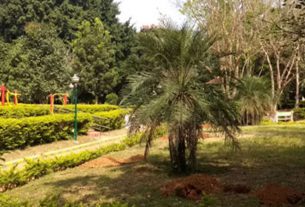The Bruhat Bengaluru Mahanagara Palike (BBMP) and Lalbagh Horticulture Department have been collaborating with the United Way of Bengaluru (UWB), a non-governmental organization to build percolation pits for water conservation, but experts opine that this may not be effective enough to recharge groundwater
Lalbagh Botanical Garden has been a reliable staple of Bengaluru with its dizzying array of exotic plants and flowers.
But if one walks past the sea green benches, pass by it’s serene lake (or pond depending on how particular one is about geography) and go behind the imposing raven hued statue of Chamraja Wodeyar,they would notice a petite and ornate series of circular concrete drain covers, painted with stick figure folk art.
These are covers specifically designed to house percolation pits which are set to be built in parks all over Bangalore.
“We have been undertaking this project since 2019,” said Radhakrishna Pradeep, the senior manager of environmental projects for United Way Of Bengaluru who said that they were courting both private and government entities for funds but only managed to get the project off the ground when they partnered with the Bruhat Bengaluru Mahanagara Palike (BBMP) and the Lalbagh Horticulture department.
“We chose parks because they were green spaces that were owned by the government and hence we could gain access to them and map them to build percolation pits,” he elaborated.
The endeavour was launched with the hope to provide relief to the groundwater crisis Bengaluru has been facing with reports of drastic drops in the eight out of nine taluks in Bangalore.
This is a recent endeavour undertaken in joint partnership by the Horticulture Departments of Bangalore and UWB. The collaboration was put into place partly to access the funds paid by private corporations under the Corporate Social Responsibility Act.
But experts have stated that these pits need to be built with precise considerations in mind in order to be functional.
“Percolation pits should be built with a precise understanding of a terrain’s gradient and topography and an understanding of high lying and low lying areas. Small scale and isolated low-lying areas will not provide relief unless the systems are understood,” said Vikram Bhatt, an urban designer and architect.
The UWB seems to be aware of this and said that they had used scientific mapping techniques, and studied land patterns, soil quality and weather patterns to decide where to build the pits.
“We have built 3,400 pits so far and we plan to build around 10,000 more pits in and around Bangalore in the next three years,” Pradeep said.
But other problems arise, such as the risk of stagnant water appearing due to clogged percolation vents. Which was the case in Dehradun (hyperlink) where a clogged percolation pit caused a stagnant water issue due to lack of timely cleaning, and with Bengaluru contending with a dengue outbreak in the winter of 2023, this could cause new issues.
“As the percolation pits are pits and not tanks, the issue of stagnant water may arise and cause harm. Percolation pits are nothing but reservoirs, you can have one or two but not as a standard (for water conservation),” said Vikram Bhatt.
The UWB said that it planned to combat the problem by jelly filling (a process in which gaps in the pits are filled with granite jelly to ensure that no other impurities get inside the percolation pits and drilling four holes in the sides for the water to drain into.
“The pits need low maintenance and have been built to protect them from silt clogging,” Pradeep said. (can’t hyperlink inside quotes)
“They only need to be cleaned once a year,” he added.
But the Lalbagh Horticulture department did not express any plans for timely cleaning.
“We have no plans in place to regularly clean the pits, it is a natural process and there is no need for such measures,” said an official working under the deputy director of the Lalbagh Horticulture Department.
Experts propose a mixed response to the solution where other measures along with percolation pits should be employed to have effective groundwater replenishment.
“Percolation pits alone are not a robust design solution. Measures like the underground discharge channel in Tokyo and bioswales would be more effective in addressing groundwater depletion along with percolation pits,” Vikram Bhatt said. (hyperlink inside quote)
The UWB expressed plans to construct injection wells where aquifers would be directly recharged through a network of cisterns to collect surface runoff water and directly recharge aquifers.
“This project has not been commenced since it requires more research so we can identify the precise location of each aquifer,” Pradeep said.




